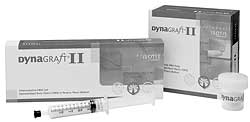DBM products gaining 510(k) approval as devices
Several firms applied for clearance in response to changing FDA regulations for these kinds of tissues.
|
The list of manufacturers and distributors of demineralized bone matrix products that received FDA 510(k) premarket approval early this year started looking like a Who’s Who of U.S. tissue banks and orthopedic companies.
For example, Regeneration Technologies gained FDA approval in February for its two demineralized bone matrix (DBM) products: Opteform and Optefil. IsoTis Orthobiologics had its DynaGraft II product approved on April 4. The next day, the FDA granted 510(k) approval to the Musculoskeletal Transplant Foundation, Edison, N.J., for its DBX brand of DBM.
All were among the growing number of companies whose DBM products are now FDA-approved, a process that started when Exactech and Wright Medical Technologies received the first approvals in March 2004. These developments followed the FDA’s decision to move these tissue-based products from being regulated, under the jurisdiction of the Center for Biologics Evaluation and Research (CBER), to regulation as medical devices, under the Center for Devices and Radiological Health (CDRH).
FDA changes
Originally designated solely as minimally manipulated human cellular tissue/products (HCT/P) intended for transplantation, the CBER regulated DBM products under 21 CFR, Parts 1270 and 1271, said CBER spokesperson Paul Richards. The rationale for switching DBMs from the CBER, where they were designated as HCT/Ps not requiring approval, to the CDRH, where they did require it, stemmed from the fact that the majority of products sold consisted of DBM combination products, those coupled with a nonbiologic carrier, he said.
Therefore, DBMs that do not have biologic carriers, including reverse-phase mediums, gels and other materials, now need to be regulated as medical devices, Richards told Orthopedics Today. This encompasses the majority of DBM sold in this country, according to Carrie Hartill, vice president of regulatory and quality assurance at Regeneration Technologies in Alachua, Fla.
Letters from the FDA
In April 2003, the FDA took what Hartill called a “blanket approach” to changing the regulatory landscape of DBMs by sending each manufacturer and distributor a letter stating that they were required to obtain 510(k) approval for their DBM products, and why. In response, Regeneration Technologies worked on their approval, first following two guidance documents that FDA recommended they use, and then conducting studies of its Opteform and Optefil products in spinal and bone defect applications using a rabbit model. The latter took about 52 weeks, she said.
|
Regeneration Technologies made its final FDA submission in October, leading to this year’s approval for both products.
In a statement, Wright Medical officials said they received a similar letter from the FDA pertaining to their Allomatrix injectable DBM putty. Wright’s submission “was made in response to FDA’s clarification to allograft putty providers, including Wright, that such products are regulated under the federal Food, Drug and Cosmetic Act and require premarket review submissions,” they said in the release.
Exactech, in Gainesville, Fla., first in line to gain approval last year, sought it for a product that was in development at the time, which according to reports is still not yet being sold. According to an Exactech press release, that human allograft bone paste product was geared toward spinal applications and used synthetic bioabsorbable polymer carrier technology licensed from Genzyme Corp.
Early market edge softens
|
Some in the field said those firms that received early product approvals simply wanted to gain a market advantage. But, with so many recent approvals, that clearly is no longer the case.
Still, having such approval may be advantageous in international markets or when working with certain hospitals, she said. “But, in the eyes of the surgeons, I don’t think it makes a whole lot of difference.”
Holding out
At the same time, a handful of companies have not yet made FDA submissions for approval of their products. Some contend their carriers are totally biologic. IsoTis Orthobiologics’ Accell Total Bone Matrix product reportedly fits the definition of a fully biologic DBM, according to the product’s documentation, since it is made of 100% DBM.
In the case of Osteotech, the firm initially fought the new requirement, claiming it received a special ruling in the mid-1990s identifying its glycerol carrier as inert. However, Hartill said she thinks the FDA now wants Osteotech to submit a 510(k) application for its Grafton DBM-based products.
The FDA’s final rules on tissue donor eligibility and good tissue practices go into effect May 25.


